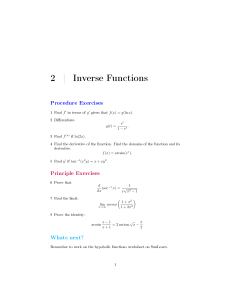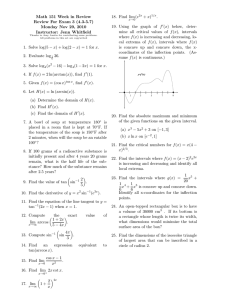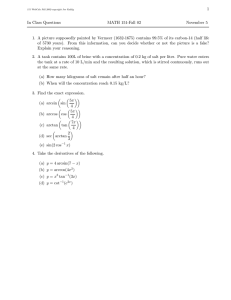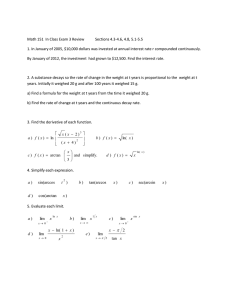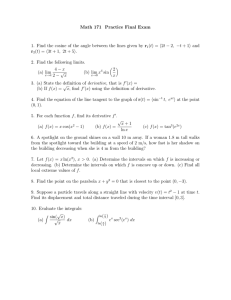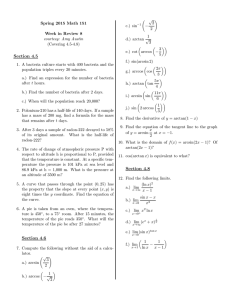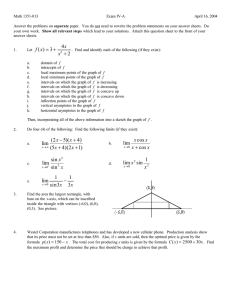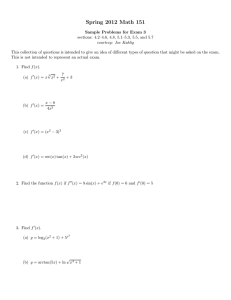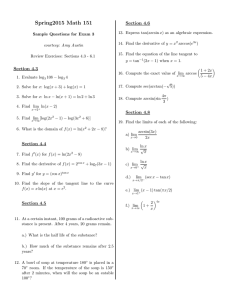MATH 151, Fall 2015 Practice Exam PART I: Multiple Choice
advertisement
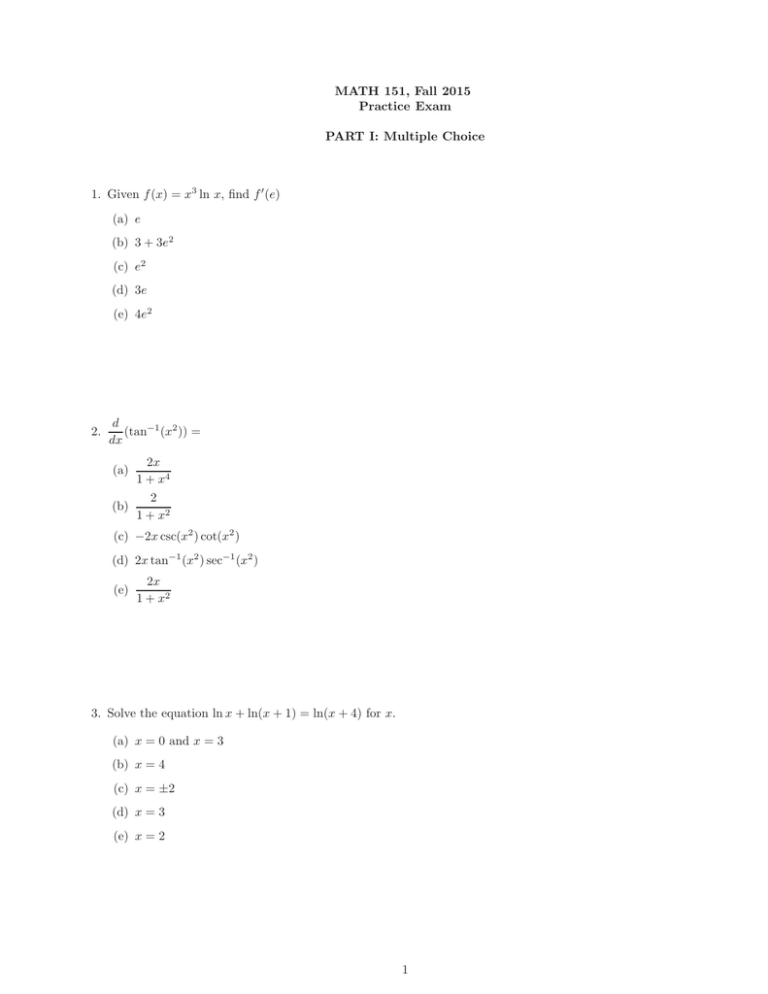
MATH 151, Fall 2015 Practice Exam PART I: Multiple Choice 1. Given f (x) = x3 ln x, find f ′ (e) (a) e (b) 3 + 3e2 (c) e2 (d) 3e (e) 4e2 2. d (tan−1 (x2 )) = dx (a) 2x 1 + x4 (b) 2 1 + x2 (c) −2x csc(x2 ) cot(x2 ) (d) 2x tan−1 (x2 ) sec−1 (x2 ) (e) 2x 1 + x2 3. Solve the equation ln x + ln(x + 1) = ln(x + 4) for x. (a) x = 0 and x = 3 (b) x = 4 (c) x = ±2 (d) x = 3 (e) x = 2 1 4. The graph of the DERIVATIVE of a function is shown below. On which intervals is the original function f concave down? CIRCLE ALL CORRECT CHOICES-THERE MAY BE MORE THAN ONE! GRAPH OF DERIVATIVE f’ 2 –10 –8 –6 –4 –2 2 4 x 6 8 10 0 –2 –4 –6 –8 –10 –12 (a) (−∞, −5) (b) (−5, 0) (c) (0, 4) (d) (4, ∞) (e) none of these intervals 1 5. Circle ALL the critical values of f (x) = x(x − 1) 3 NOTE: YOU MAY CIRCLE MORE THAN ONE CHOICE! (a) 0 (b) − 1 3 1 4 3 (d) 4 (c) (e) 1 h πi 6. Find the absolute maximum of f (x) = sin x + cos x on the interval 0, . 3 √ √ (NOTE: 2 ≈ 1.414 and 3 ≈ 1.73) (a) 1 (b) 2 √ (c) 2 √ 3+1 (d) 2 π (e) 4 2 7. The inflection points of f (x) = x5 + 10x4 occur at which of the following? (a) x = 6 only (b) x = −6 only (c) x = 0, x = −8 (d) x = 0, x = −6 (e) x = 0, x = 6 √ 1 8. Which is an antiderivative of f (x) = 2 x + 2 ? x 1 4 3 x2 − + C 3 x 4 3 (b) x 2 − ln(x2 ) + C 3 2 1 (c) √ − 3 + C x x (a) 1 (d) √ + ln(x2 ) + C x 1 1 (e) √ − + C x x 9. Given x = 2 is a critical number for f (x) = x3 e−bx , what is b? (a) 3 2 (b) 8 1 (c) − ln 8 2 2 (d) 3 (e) 12 3 x 10. tan arccos = 2 x (a) √ 2 x +4 1 (b) − √ 4 − x2 √ 4 − x2 (c) x 2 (d) 2 x +4 x (e) √ 4 − x2 11. Find lim x→0 arctan x − x x3 1 3 1 (b) − 2 (a) − (c) 0 (d) ∞ (e) 6 4 PART II WORK OUT Directions: Present your solutions in the space provided. Show all your work neatly and concisely and Box your final answer. You will be graded not merely on the final answer, but also on the quality and correctness of the work leading up to it. 12. Find the derivative of (i) f (x) = xsec x (ii) 2arcsin x + log2 (x2 ) 5 13. Find lim (1 − x) x x→0 5 14. For f (x) = x2 ln(x): a.) Find the domain of f (x). b.) Find lim+ f (x). x→0 c.) Find the intervals where f (x) is increasing and decreasing and find all local extrema of f (x) 15. Find the intervals of concavity and inflection point(s) for f (x) = xe4x 6 16. If 1200 square cm of material is available to make a box with a square base, find the largest possible volume of the box. 17. The acceleration of a particle is given by a(t) = (1 + et )i + (cos t)j. If the initial velocity is i and the initial position is j, find the position of the particle at any time t. 7 18. A thermometer is taken from a room where the temperature is 75◦ to the outdoors, where the temperature is 35◦ . After one minute, the thermometer reads 60◦ . What is the reading of the thermometer at time t? 19. A bacterial culture starts with 200 bacteria and triples in size every half hour. Assuming exponential growth, how many bacteria are there after 45 minutes? 8 20. Find the following: a.) arccos 1 = 2 4 b.) sin arccos − = 5 5π = c.) arcsin sin 6 d.) The domain of arcsin(4x − 5) = 21. If g(x) is the inverse of f (x) = x5 + e2x + 8, find g ′ (9). 22. Find the inverse of f (x) = 3 + ln x . 2 − 5 ln x 9
